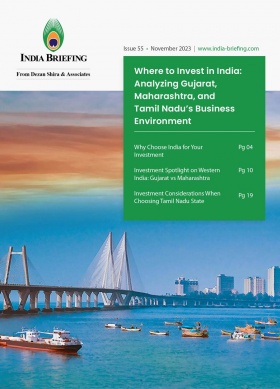Emerging Technologies Supporting Your India Retail Strategy: Location Analytics
We discuss how technology-enabled tools are allowing retailers to optimize their India market strategy using location analytics. This becomes more important as India’s spending power is spread differently across the country and consumer preferences for offline and online shopping are becoming more dynamic, supported by increasingly robust last mile logistics.
India’s retail sector is experiencing a period of robust growth driven by various factors, such as rising national wages, rapid urbanization, and the emergence of the digital economy. This growth is not limited to metropolitan areas but is extending to lower-tier cities as well, thanks to an expanding network of last-mile logistics suppliers facilitating access to online platforms. The retail landscape in India is diverse, offering choices ranging from global e-commerce platforms to single-brand shopping websites and social media sellers. This diversification aligns with the rising discretionary spending power of consumers, with per capita income projected to exceed US$12,000 by 2047.
Several key growth drivers are fueling investments in India’s retail industry. India ranks as the fourth largest retail destination globally, with significant expansion seen in the number of retail precincts and in leasing and supply addition. The country’s online retail market is also poised for substantial growth, projected to reach US$325 billion by 2030, offering businesses opportunities to tap into a burgeoning digital economy.
The attractiveness of the Indian market has increased amid a deceleration in prominent developing markets such as China, which is grappling with an economic downturn. Meanwhile, other developed markets like the United Kingdom and the United States are either experiencing a slowdown or are forecast to enter one.
Given the favorable circumstances, a significant number of foreign retailers are rushing to establish their presence in the Indian market. A considerable portion of these newcomers have forged alliances with established retail giants like Aditya Birla Fashion and Retail (ABFRL), Reliance Retail, Tata Trent, and others, capitalizing on their deep market insights and adeptness in navigating regulatory landscapes. These partnerships are also essential because although the Indian retail sector permits 100 percent foreign investment, companies with foreign direct investment (FDI) exceeding 51 percent are mandated to procure at least 30 percent of the value of goods from India, to open their own retail outlet. The application of FDI rules also depend on whether the company is engaging in single brand or multi-brand retail in India and whether sales are being made via online, offline, or omnichannel routes.
Choosing the right location: India market entry for retailers
When a company decides to venture into the Indian retail market, it encounters various challenges ranging from regulatory hurdles to building or expanding supply chains and understanding consumer preferences. However, a primary challenge it faces is conducting location analysis for opening a new retail outlet. This task can be particularly daunting in India due to its extensive population spread across over 8000 cities, and the steady transformation of many neighborhood markets into high streets across these cities.
A comprehensive evaluation of the potential benefits and limitations of a specific location is crucial for fostering sustainable growth and success in the retail sector. Research conducted by Knight Frank India indicates that the growth of the retail industry heavily relies on the location and convenience factor, such as the availability of parking, visibility, and ease of access.
A retail business’s presence is more noticeable to customers, guests, and bystanders when services and infrastructure surround it. In well planned retail locations, good connection, parking options, and public transit may also improve consumer convenience and encourage repeat business, which raises the likelihood that customers will recognize and remember the brand.
Given the anticipated increase in the inventory of retail precincts—projected to reach 40 million square feet of just shopping mall space across India’s top seven cities by the end of 2027—it is imperative to conduct comprehensive research to pinpoint the ideal location that corresponds with the target demographic and maximizes growth opportunity.

Today, whether they are grocery, food and beverage (F&B), or fashion brands, most rely on a combination of multiple channels like e-commerce and brick & mortar (omnichannel strategy) business models. Consequently, the significance of mapping areas where businesses can draw customers from has never been greater when choosing retail outlets and warehousing.
Read: Key Considerations Before Selling Foreign Products in India
How technology supports data challenged markets like India
Establishing or expanding physical stores requires significant capital investment, making location and network analysis (network of stores) a continuous exercise. In contrast to other nations where companies can readily access data for making business decisions, obtaining such data can be challenging or unavailable in India.
To aid businesses in this effort, numerous location intelligence firms have emerged, providing access to geospatial data essential for network analysis. This is particularly beneficial in countries like India, as such information is indispensable for informed decision-making.
Various technology-enabled tools, such as cloud-based mapping platform models, are dominating the delivery of geospatial data. This refers to data describing objects, events, or other features with a location on or near the surface of the earth and functions. The tools are easy to use, allow for faster decision-making, and are cost-effective for running sophisticated data analyses.
One of the biggest benefits of cloud-based, location intelligence software is that it enables brands that have physical stores in multiple countries to have one log-in to manage all their locations. Customers can also create their own large data set and visualize it through thematic layers and show comparisons with the available data on the platform.
What is location analytics?
Location analytics integrates geographical data pertaining to assets, infrastructure, transportation, and the environment with an organization’s operational and customer data to unveil robust solutions for any business obstacle, subsequently disseminating these insights across the entire organization.
What type of insights can be provided by location analytics?
Leveraging location analytics is pivotal for addressing critical business inquiries within the retail sector. These inquiries encompass:
- Identifying the most promising regions and cities for brand expansion and quantifying their potential using comprehensive metrics.
- Understanding the optimal number of stores to add at both national and regional levels, as well as gauging the capacity of cities across different tiers, forms a foundational aspect of strategic expansion planning.
- By delving into the economic prosperity of cities, businesses can formulate tailored metrics to guide targeted store expansions, thus maximizing growth opportunities.
- Analyzing competitor presence across India, aiding in benchmarking market share and pinpointing areas for enhancement.
- Evaluating existing store performance through the lens of location-specific factors empowering businesses to fine-tune their strategies. Moreover, pinpointing high-potential catchment areas for new store openings and assessing their value equips decision-makers with valuable insights for informed expansion decisions.
- Balancing priorities between mall, high street, and neighborhood stores.
Key takeaways
The expansion of retail stores in India using location analytics will introduce key efficiencies for businesses aiming to tap the growing spending power in the country’s burgeoning market. This is essential for foreign retailers in particular as India’s vast population is spread across a wide geography, with diverse socioeconomic and cultural factors shaping consumption patterns.
Nevertheless, rising urban incomes and the fast rate of digital adoption offers huge prospects to the retail sector for investment and expansion.
Location analytics can aid retail investors with tools and data insights that can enable optimal decision-making—location of the store, parking access and space, surrounding connectivity and commercial infrastructure, consumer behavior in that area, competitor presence, etc. Such information will be key to the retail outlet’s performance and thereby brand power, impacting the company’s long-term success in the Indian market.
As India’s shopping real estate continues to expand, conducting thorough research and utilizing location analytics tools will be imperative for retailers to pinpoint ideal locations and capitalize on growth potential. By balancing priorities between different types of retail spaces and adapting to evolving consumer preferences, businesses can position themselves for sustainable success in India’s dynamic retail landscape.
For guidance and support in navigating India’s retail landscape and setting up a business in India, feel free to reach out to our advisory team at India@dezshira.com.
About Us
India Briefing is produced by Dezan Shira & Associates. The firm assists foreign investors throughout Asia from offices across the world, including in Delhi and Mumbai. Readers may write to india@dezshira.com for more support on doing business in India.
We also maintain offices or have alliance partners assisting foreign investors in Indonesia, Singapore, Vietnam, Philippines, Malaysia, Thailand, Bangladesh, Italy, Germany, and the United States.
- Previous Article Increasing Private Sector Participation Vital for India’s Infrastructure Sector
- Next Article Consideraciones claves antes de vender productos extranjeros en la India









